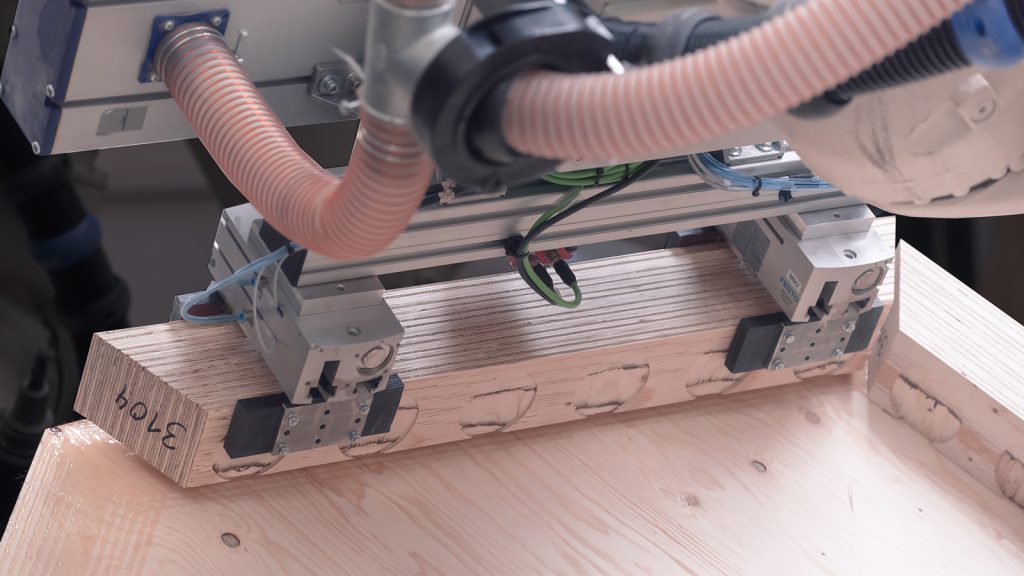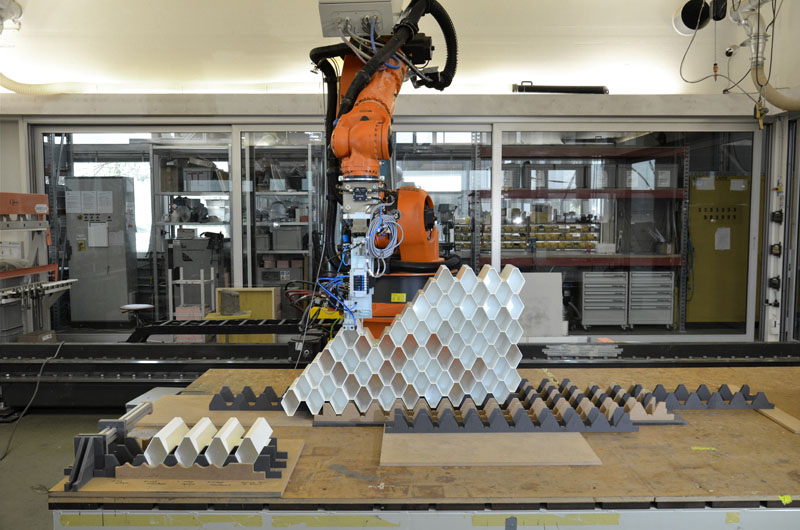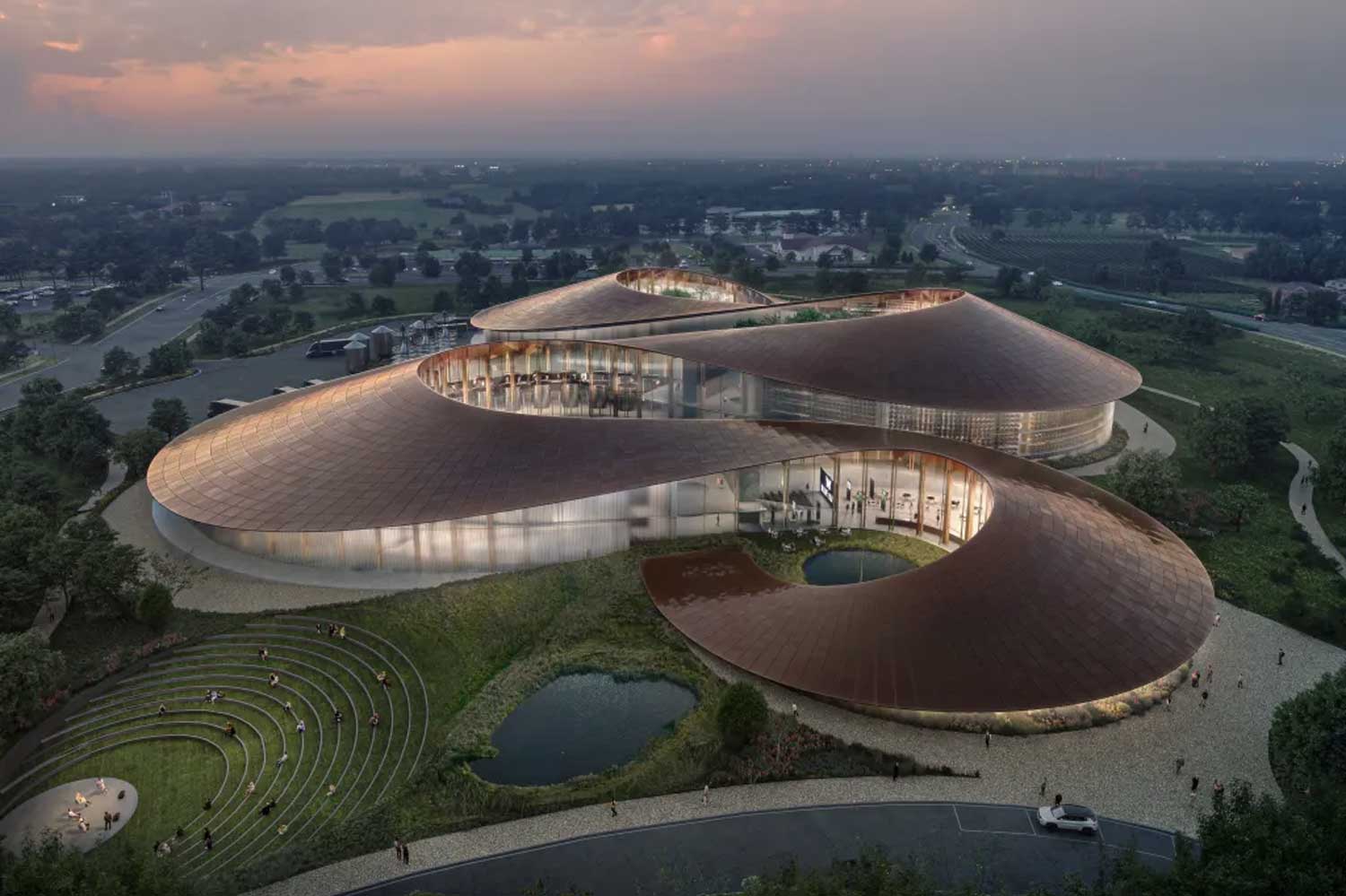
Industrial robots are changing how we make everything. These tools are progressively changing how buildings are made by bridging the gap between the concept of a design and the way design is completed. Wood construction is at the forefront of this transformation. Using robotics allows us to assemble more pieces and complex pieces that, in totality, result in higher-performing components. Additionally, integrating robotic technologies with wooden materials can potentially lead to more sustainable building practices, as it can help to minimize the amount of material needed and reduce the amount of waste generated.
This article will explore the potential, history, current applications, and challenges of robotic fabrication with wooden materials.
Before we dive into the specifics of robotic fabrication with wood, let’s first talk about why it can be such a helpful tool.
The Upsides of Incorporating Robotics and Wood

When discussing the general benefits, first and foremost, robotics provide a degree of accuracy and repeatability that conventional woodworking processes cannot match. You can produce precise cuts and shapes using a robot that would be difficult or impossible to do by hand. Furthermore, robots may aid in accelerating the manufacturing process. You may get more work done in less time by automating some tasks. This is particularly useful for large-scale operations that would otherwise need significant work.
Not to undermine, robotic fabrication can assist in reducing the risk of workplace injury. Workers may concentrate on safer and simpler activities, while a robot performs physically demanding jobs requiring a high skill level.

Moreover, different techniques can be applied when using robotics to fabricate with wood. While robotic arms can be utilized to perform tasks such as cutting, drilling, and milling, 3D printers will use various techniques to build up layers of wood, creating objects with a high level of detail and accuracy. In addition, these robots can perform tasks such as sanding, painting, and assembly in many companies or research labs. By automating these tasks, they can achieve a higher level of consistency and reduce the risk of human error.

On the other hand, wooden materials provide some intrinsic potentials that make them valuable as architectural materials. The key characteristics will include the following:
- Strength and durability: wood is a strong and durable material that can withstand various stresses and loads, making it suitable for multiple structural applications.
- Versatility: wood can be used in various applications in architecture, including framing, cladding, flooring, and furniture. It can be shaped and finished in numerous ways, making it highly versatile.
- Aesthetics: wood has a natural beauty and warmth that make it an attractive material for use in architecture. It can create various visual effects, from rustic to modern, depending on the type of wood and the finish applied.
- Sustainability: wood is a renewable resource that can be sustainably harvested and used in construction, making it an environmentally friendly choice for building materials.
- Thermal properties: wood has good thermal insulation properties, making it an energy-efficient material for buildings. It can help keep buildings warm in the winter and cool in the summer, reducing the need for cooling and heating systems.
- The smell and the haptic of wood supply a part of a unique experience.
- Wood produces lightweight constructions.
Early Innovations and Milestones:

Using robotics in woodworking has come a long way. Over the years, advances in technology and manufacturing techniques have led to significant progress in using robots for woodworking tasks. These early advancements include the FAMULUS robot, CNC machines, and 3D printer technology.
The first recorded usage of a robot in woodworking dates back to 1973 when a German firm named KUKA made history as a robotics pioneer by developing the world’s first industrial robot with six electric motor-driven axes. This robot could do basic tasks like drilling and milling, which was a significant milestone in the employment of robots in woodworking since it revealed the industry’s automation potential.
The advancement of computer numerical control (CNC) technology in the 1980s and 1990s enabled robots in woodworking industries to execute increasingly accurate and complex tasks. CNC technology, which uses computer-controlled equipment to perform activities such as cutting and milling, has dramatically improved the precision and efficiency of woodworking processes.

Moreover, the advent of 3D printing technology in the 1990s and gaining media visibility in the 2000s offered new possibilities for producing complicated wooden objects and structures using robots. Using 3D printing to fabricate wood structures made it possible to create complex, customized, and innovative structures, resulting in greater design flexibility.
Besides, there have been several innovations in the use of robotics in recent years. There are being integrated within many tasks with multiple axes of motion or built-in sensors to allow for more precise and complex cuts and shapes.
Current Applications of Robotic Fabrication with Wooden Materials

Today, robotics in woodworking is rapidly expanding and evolving from everyday furniture and pavilions to futuristic skyscrapers. In this section, we’ll look at some of the exciting and innovative ways robots are currently integrated with wood.
HygroSkin: Meteorosensitive Pavilion

The HygroSkin – Meteorosensitive Pavilion project by ICD investigates a revolutionary kind of climate-responsive architecture. While most efforts at environmental responsiveness depend significantly on expensive technological equipment placed on otherwise lifeless material structures, this concept relies on the material’s responsive potential. The dimensional instability of wood concerning moisture content is used to create a metereosensitive architectural skin that opens and shuts autonomously in reaction to weather changes while requiring no operating energy or mechanical or electronic control.
The modular wooden skin of the traveling pavilion is developed and manufactured by leveraging the self-forming ability of initially flat plywood sheets to generate conical surfaces depending on the material’s elastic nature. A weather-responsive aperture is positioned into each robotically manufactured module’s deep, concave surface. Materially programming the humidity-responsive behavior of these apertures allows for a breathtakingly basic but profoundly ecologically integrated design in continual feedback and interaction with its surroundings.
BUGA Wood Pavilion

The BUGA Wood Pavilion represents a unique perspective on digital timber construction. Its segmented wood shell is based on biological principles discovered in the plate skeleton of sea urchins, which have been investigated for almost a decade by the University of Stuttgart’s Institutes for Computational Design and Construction (ICD) and Building Structures and Structural Design (ITKE).
A robotic manufacturing platform was created as part of the project to automate the assembling and milling of the pavilion’s 376 custom hollow wood components. This manufacturing method guarantees that all parts fit together with sub-millimeter accuracy, much like a large three-dimensional puzzle. The magnificent wooden roof spans 30 meters over one of BUGA’s primary event and performance spaces, using little material while creating a one-of-a-kind architectural environment.
ICD Sewn Timber Shell

The Sewn Timber Shell studies the use of robotics and sensing systems in conjunction with garment design and industrial sewing methods to research a new method of constructing tailored wood structures while reconnecting with traditional craftsmanship. Thin sheets of plywood replace the fabric, establishing a new relationship between material pliability and stiffness and, as a result, introducing the loadbearing capability to the unique material system. Sewing is comparable to garment design in that the seams allow for the tailoring of three-dimensional curving forms from a flat sheet material that envelopes the body.
When implemented on a larger scale, the seams form linkages that shape the material based on the elastic bending of wood, resulting in structural capacity and spatial confinement.
An adaptive robotic manufacturing technique allows for the required scaling-up and the management of the complicated interrelationships between patterning forms and material behavior. In contrast to repetitive manufacturing processes, where automation is based on the execution of preset and completely specified phases, sensing technology allows a real-time workflow that combines material computation with robotic fabrication.
The Stacked Pavilion

The West Fest Pavilion was designed as a temporary spatial structure with an integrated bar for a big public event organized by Canton Zurich. The wooden construction comprises 16 distorted components consisting of 372 slats. The whole structure is structural support, roof, and building skin all at the same time. A digitally controlled robot cut and precisely arranged the slats according to an algorithmic design. Each part is separately rotated, resulting in a sequence of slightly varied spaces. The logic of the apertures and curvatures, as well as the beautiful features, follow the laws of wood building. The classic wood substance takes on new meaning thanks to digital processing.
Semiramis

Semiramis is an artificial intelligence-driven architectural piece that was built in 2022 at the entrance of a new Tech Cluster Zug in Switzerland. It grows as a vertical urban ecosystem protected for plants and tiny local creatures, as a pioneer for the increasingly intertwined partnership between technology and people. Semiramis was founded by a plethora of synergies and research initiatives in the disciplines of interactive computational design, machine learning, and digital manufacturing. The building is 22.5 meters tall without vegetation and is made up. It is amorphous timber pods supported by eight thin steel supports.
RFS Pavilion

RFS is a robotically produced wood pavilion that investigates responsible and accurate ways of contributing to low-carbon and innovative construction outlooks. This structure was planned using bespoke algorithms created exclusively for this project and constructed using cutting-edge human-robot collaborative construction. RFS incorporates custom prefabricated wood sub-assemblies made from locally procured short 2×4 dimensional lumber and processes and assembles pieces into finely layered modules using industrial robotic arms.
Limitations of Robotic Fabrication with Wooden Materials

However, while the use of robotics in woodworking can offer many benefits, there are also several challenges and limitations to consider. Some of the main challenges and limitations include:
- Cost: one of the main limitations of using robotics in woodworking is the cost of the technology. Robots and other automation equipment may be costly to acquire and maintain, which can be a barrier for some businesses or people.
- A lack of flexibility: While robots may be incredibly accurate and efficient, their capacity to adjust to changing conditions or unanticipated challenges is restricted. This may make it challenging to employ robots for activities that need a high amount of flexibility or problem-solving.
- Complexity: Using robots in woodworking might be difficult since programming and other technical abilities are required. This may be a barrier for specific people or companies who lack the appropriate skills or finances to employ robots properly.
Wrapping Things Up

In conclusion, robotics is revolutionizing how we work with wood. With the ability to achieve a high level of precision, speed up the fabrication process, and reduce the risk of injury, it is clear that robotic fabrication is here to stay. Whether cutting, milling, or assembling, robots make creating beautiful and intricate wooden structures and objects more effortless and efficient. As we’ve seen, the current applications of robotic fabrication with wooden materials are truly impressive, demonstrating the evolution of robotics in woodworking over the years. As technology continues to advance, there will likely be further innovations and milestones in the future.
So, let us keep an eye on this intriguing and expanding topic and watch where robots will lead us next.







































